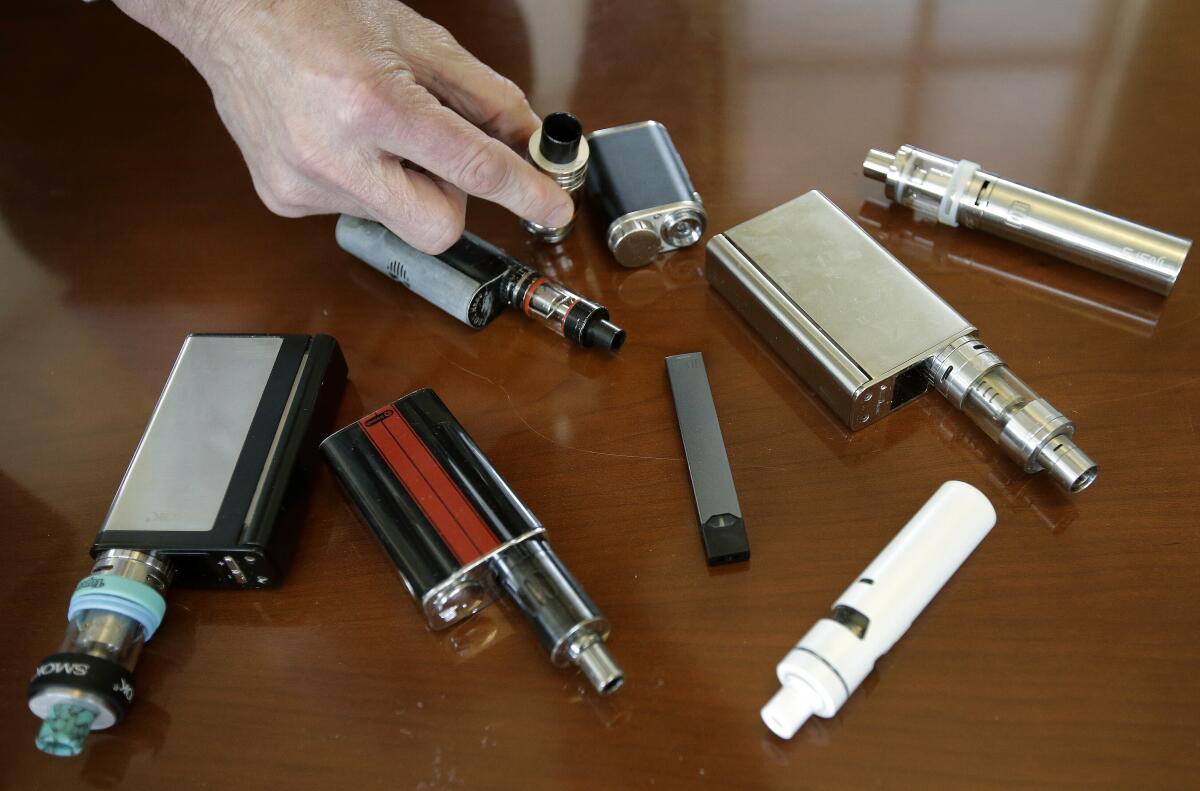Schools are using surveillance tech to catch students vaping

When Aaliyah Iglesias was caught vaping at a Texas high school, she didn’t realize how much could be taken from her.
Suddenly, the rest of her high school experience was threatened: being student council president, her role as debate team captain, and walking at graduation. Even her college scholarship was at risk. She was sent to the district’s alternative school for 30 days and was told she could have faced criminal charges.
Like thousands of other students around the country, she was caught by surveillance equipment that schools have installed to crack down on electronic cigarettes, often without informing students.
Schools nationwide have invested millions of dollars in the monitoring technology, sometimes using federal COVID-19 emergency relief money meant to help schools through the pandemic and aid students’ academic recovery. Marketing materials say that the sensors, at a cost of over $1,000 each, could help fight the virus by checking air quality.
Middle and high schools have been inundated with e-cigarettes. The devices can dispense vapor containing higher concentrations of nicotine than tobacco cigarettes. Millions of minors report vaping despite efforts to limit sales to children by raising the legal age to 21 and to ban flavored products preferred by teenagers.
Some districts pair the sensors with surveillance cameras. When activated by a vaping sensor, for example in a restroom, those cameras can capture every student who then exits.
It can surprise students that schools even have such technology.
Iglesias, who graduated in May from Tyler High School in Tyler, Texas, first learned there were sensors after an administrator came into a restroom as students started vaping.
“I was in awe,” she said.
The administrator could not tell who’d been vaping, so let all of the students go.
The episode that got Iglesias in trouble happened elsewhere in Texas — at Athens High School, where her debate team was competing last February. At one point, she went into a bathroom to vape. Later that day, her coach told her she had been caught.
“I decided to partake in something that I’m not proud of, but I did it,” Iglesias said, adding that her senior year had been stressful and that she’d “had a lot of personal stuff building up outside,” including that one of her close relatives was about to come out of jail.
She was immediately pulled from the debate tournament, and her coach told her she could face charges because she was 18. She was sent to her district’s alternative school for a month, the minimum punishment for students caught vaping in Tyler schools.
Students found vaping also can receive misdemeanor citations and be fined up to $100. Those with vapes containing THC, the chemical in marijuana that makes users feel high, can be arrested on felony charges. At least 90 students in Tyler have faced misdemeanor or felony charges.
Tyler’s school district declined to comment on the disciplinary actions, but released a statement saying that tracking vape usage addresses a problem that is hurting children’s health.
“The vape detectors have been efficient in detecting when students are vaping, allowing us to address the issue immediately,” the school system said.
A leading provider of the detectors, HALO Smart Sensors, sells 90% to 95% of its sensors to schools. The sensors don’t have cameras or record audio but can detect increases in noise in a school bathroom and send a text alert to school officials, said Rick Cadiz, vice president of sales and marketing for IPVideo, the maker of the HALO sensors.
The sensors are marketed primarily for detecting vape smoke or THC, but also can monitor for sounds such as gunshots or keywords that may indicate bullying.
“What we’re seeing with the districts is they’re stopping the vaping in the schools with this, but then we don’t want a $1,000 paperweight that the school invests for no other uses, right?” Cadiz said. “We want it to be a long-term investment.”
After the COVID pandemic started, HALO noted on its website that monitoring indoor air quality was an approved use for federal relief money.
“With the HALO Smart Sensor, you can combat COVID-19 in your schools and create a safe work and learning environment, while also reaping the benefits of vape detection, security monitoring, and more,” the company said.
Schools now can also use some of the nearly $440million that e-cigarette maker Juul Labs is paying to settle a lawsuit that claimed it was marketing its products to youth, Cadiz said.
The company is aware of privacy concerns around the sensors, Cadiz said.
“All it’s doing is alerting that something’s going on,” he said. “You need someone to physically investigate the alert that comes out.”
The sensors don’t always work as school officials hope.
At San Dieguito Union High School District in San Diego County, vape fumes in bathrooms were sometimes so thick that students complained they were unbearable. In a pilot program, the district installed vape sensors inside restrooms and cameras outside their doors.
“In a way, it was too successful,” said Michael Allman, a district board member. He said the sensors were going off so frequently that administrators felt it was useless to review security video each time.
On social media, students around the country describe ways to outsmart the sensors. Some report covering them in plastic wrap. Others say they blow the vapor into their clothes.
At the Coppell Independent School District in Texas, sensors are part of a prevention strategy that includes educational videos and a tip line. Students can receive $50 for reporting vaping by peers, and “they were turning each other in right and left,” said Jennifer Villines, the district’s director of student and staff services.
Students can be sent to an alternative school or serve in-school suspensions, but are not expelled for vaping, she said.
“We want our kids here. If they’re not here, they’re not learning,” Villines said. “We also feel like in some cases, behaviors such as these are coping mechanisms, and we want to keep them in our environment, where they learn to self-regulate.”
For Iglesias, the consequences included having to step down as student council president and debate captain and leaving the National Honor Society. At the alternative school where she spent a month, students do regular coursework but do not attend classes, and are not guaranteed the materials that they would normally be studying.
Iglesias was still able to attend prom, walk at graduation and stay in most of her clubs. She also kept her college scholarship, and now attends Tyler Junior College.
But she says the punishments for vaping have gone too far.
“The people that make these policies and implement these things sit in a room and do not walk the campuses or see the results — the consequences to these policies that they’re making — to actually ensure that it’s working, because it’s not,” she said. “I’m never going to do something like that again, because the repercussions I faced were horrible.”
This story is a collaboration between student journalists at Stanford University and the University of Missouri, in partnership with the Associated Press. In addition to Munis from Stanford University and McCarthy from the University of Missouri, the following student reporters contributed to this report: Yasmeen Saadi, Mikaela Schlueter, Asplen Gengenbacher and Alexis Simmerman from the University of Missouri; Parker Daly, Elise Darragh-Ford, Emily Handsel, Henry Hill-Gorman, Victoria Ren, Shaurya Sinha, Carolyn Stein and Jessica Yu from Stanford University.
More to Read
Sign up for Essential California
The most important California stories and recommendations in your inbox every morning.
You may occasionally receive promotional content from the Los Angeles Times.










